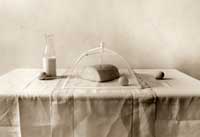David Halliday
Everyday objects become extraordinary still lifes through the lens of a New Orleans photographer
by Mimi Read, SOUTHERN ACCENTS

Still Life with Milk, Bread and Eggs, 2000
When David Halliday wanders through a grocery store or farmer’s market, he’s just like any other gourmet shopper on the lookout for a crisp bunch of arugula or a pristine fillet of salmon. He’s an excellent cook who spent much of his 20s working as professional chef in New York.
Photographer David Halliday created Still Life with Milk, Bread and Eggs (15 1/2 by 22 inches, sepia-toned silver-gelatin print, 2000) out of the simplest foods.
But then the artist will notice a pumpkin with sculptural curves, a mound of pecans with striated shells, or some shockingly compelling specimen, such as the long, spiraling cucumbers he once came across in Greece. At that moment, life slips into art, and Halliday follows. He begins foraging not for dinner but for the elegant, meticulously composed still life photographs that he’s been creating and showing in galleries throughout the country for the past decade.
“That’s the point of my work—to show that the borders between life and art are blurry,” says Halliday, an easygoing, bright-eyed 45-year-old who tends toward cutoff shorts, rumpled shirts in amazing colors, and a day’s growth of beard. “Things come out of the market, the garden, the kitchen cabinet. It’s often happenstance. Sometimes I find pieces in antiques shops, like this pewter compote that lately I can’t stop using. Or friends bring me things.”
His friend Steve Coenen, a New Orleans landscaper, once brought him a bunch of bananas that was still attached to a long, outlandish flower stalk. Coenen had been caring for the garden of a woman who despised bananas. “It was a ‘one man’s trash is another man’s treasure’ situation,” says Halliday, who decided to use the fruit to create the ravishing, provocative pair of photographs he titled Banana Diptych.

Watermelon and Blackberries, 2003
In Watermelon and Blackberries (7 x 9 inches, sepia toned silver-gelatin print, 2003), glistening summer fruits harvested from Halliday’s garden become a richly rendered still life with luminous toning.
When an artist friend brought him a dead, intact cicada, it enthralled him so much that he photographed it by itself and close-up, with as much wonder as a 19th-century British naturalist who had just made a ground-shaking discovery.
Many of his photographs are as lush and carefully composed as 17th-century Dutch still life paintings, such as the one of a compote spilling ripe blackberries, a spoon, an artichoke, two shallots, and an old, white garden rose tilted in a glass.
Like a painter, Halliday emphasizes volumes, balances, textures, areas of subtle shading, and chiaroscuro. A few images seem more modern, mesmerizing with their radical purity, such as his photograph of one small, white seashell, its spiraling grooves as legible as a fingerprint.
And whether they are as dark as bronze or copper, as white as platinum, or somewhere in between, Halliday’s sepia-toned silver-gelatin prints are so lavishly rich and so carefully calibrated in tone that worldly objects are elevated into the realm of imagination. They look like vintage prints or paintings.
He has transmuted produce and other objects into a visual language suffused with history, emotion, nostalgia, a sense of time rushing past, and the love of beauty. And even though it’s not exactly Southern, his work is certainly informed by the fertility, humidity, and historical richness of New Orleans.
“Most people think that a photograph is just a picture of an object, that it’s something literal,” says Vickie Bassetti, director of Bassetti Fine Art Photographs, the New Orleans gallery where Halliday showcases his work. “Well, that’s just the beginning. For David, every millimeter of an image is considered. He’s pacing the whole thing, orchestrating the relationship between the parts, and directing.” With prints ranging in price from $600 to $7,500, the photographer’s work sells quickly.
If Halliday shies away from saying what his photographs might mean or why he focuses so much effort on the still life, he’s not being cagey. It’s more like humility. He’s well-aware that in the hierarchy of artistic genres, still lifes are often considered frivolous or decorative, and he refuses to try and dismantle such a judgment. He’d much rather smile charmingly and give a thoughtful, boy-next-door answer. “Maybe it’s because I am, at heart, very disorganized and a pack rat,” he says. “These photographs are my fantasies, my way of saying, ‘Ah, if everything could just look like this, so nicely arranged.'”
Born in Glen Cove, New York, Halliday bounced around the Northeast until the late ’80s, when he moved to New Orleans to take a job as a chef at The Bistro at the Hotel Maison de Ville. Since high school, he had practiced photography and excelled at art. But it was only when he became disenchanted with cooking that he picked up the camera in earnest. Almost immediately, the artist found a gallery, and his work gained an audience.
“He’s a natural,” says Halliday’s friend Amy Weiskopf, a renowned New Orleans artist who paints realistic still lifes of everyday items such as vegetables, fruit, fish, and kitchen utensils. “He has a direct relationship to his aesthetic world. For him, gardening, working on the house, cooking, or making photographs—it’s all very connected.”
